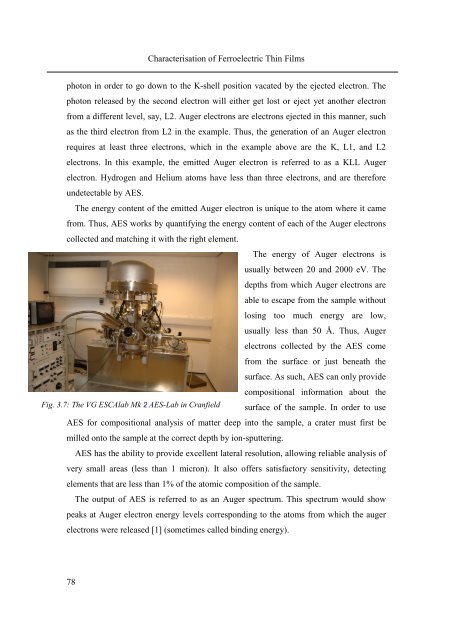PhD Thesis Arne Lüker final version V4 - Cranfield University
PhD Thesis Arne Lüker final version V4 - Cranfield University
PhD Thesis Arne Lüker final version V4 - Cranfield University
You also want an ePaper? Increase the reach of your titles
YUMPU automatically turns print PDFs into web optimized ePapers that Google loves.
78<br />
Characterisation of Ferroelectric Thin Films<br />
photon in order to go down to the K-shell position vacated by the ejected electron. The<br />
photon released by the second electron will either get lost or eject yet another electron<br />
from a different level, say, L2. Auger electrons are electrons ejected in this manner, such<br />
as the third electron from L2 in the example. Thus, the generation of an Auger electron<br />
requires at least three electrons, which in the example above are the K, L1, and L2<br />
electrons. In this example, the emitted Auger electron is referred to as a KLL Auger<br />
electron. Hydrogen and Helium atoms have less than three electrons, and are therefore<br />
undetectable by AES.<br />
The energy content of the emitted Auger electron is unique to the atom where it came<br />
from. Thus, AES works by quantifying the energy content of each of the Auger electrons<br />
collected and matching it with the right element.<br />
Fig. 3.7: The VG ESCAlab Mk 2 AES-Lab in <strong>Cranfield</strong><br />
The energy of Auger electrons is<br />
usually between 20 and 2000 eV. The<br />
depths from which Auger electrons are<br />
able to escape from the sample without<br />
losing too much energy are low,<br />
usually less than 50 Å. Thus, Auger<br />
electrons collected by the AES come<br />
from the surface or just beneath the<br />
surface. As such, AES can only provide<br />
compositional information about the<br />
surface of the sample. In order to use<br />
AES for compositional analysis of matter deep into the sample, a crater must first be<br />
milled onto the sample at the correct depth by ion-sputtering.<br />
AES has the ability to provide excellent lateral resolution, allowing reliable analysis of<br />
very small areas (less than 1 micron). It also offers satisfactory sensitivity, detecting<br />
elements that are less than 1% of the atomic composition of the sample.<br />
The output of AES is referred to as an Auger spectrum. This spectrum would show<br />
peaks at Auger electron energy levels corresponding to the atoms from which the auger<br />
electrons were released [1] (sometimes called binding energy).

















